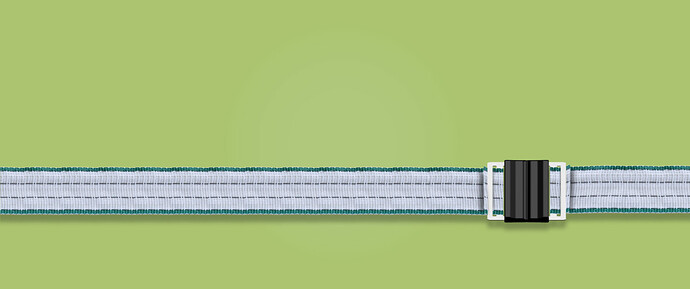One of the most important decisions when designing a pasture fence is the choice of the suitable conductive material. You can choose between Polyrope, Polywire, and Polytape. In these plastic conductive materials, the conductive wires (e.g., Niro or copper wires) are woven into non-conductive plastic threads. Thus they are flexible to use, very light and easy to assemble or to dismantle.
Tips for Using the Polytape:
Polytape is available in several widths: 12,5 mm, 20 mm, and 40 mm. It is particularly suitable for large animals such as horses and cattle, because the tape’s visibility is crucial for them. Horses and cattle need this optical barrier, so that they quickly learn that the tape is electrically charged and avoid it. For horses, the 40 mm Polytape is especially suitable. The broad tape is a good barrier as the top line of fencing for animals fond of galloping. The tape can be easily combined with 20 mm wide Polytape below it.
For cow and cattle fencing, two rows of at least 12.5 mm tape in the top row and Polywire in the lower row is advisable. This combination reduces the risk of injury if the animals happen to break through the electric fence.
Tips for Buying Polytape:
For shorter fences or portion pastures, a UV stabilized standard Polytape is adequate (such as EconomyLine).
For medium to long fence systems, the weather-resistant TopLine Plus Polytape is ideal, because it has excellent conductivity and longevity.
The resistance (Ω/m) should be as low as possible because the conductivity of the fence is dependent on it. Thanks to its thick, tin-plated copper conductor, a Premium-Polytape guarantees 40x higher conductivity and highest safety — even with very long fences.
AKO Premium Line Polytape.jpgA premium Polytape has the further advantage of reinforced outer edges and thus a particularly good tensile strength in long fence systems.
In areas with challenging weather conditions, it is worth investing in a particularly strong electric fence, whose thick polyethylene threads ensure the highest tensile strength and longevity. In addition, its first-class conductive material TriCOND™ has 7 x higher conductivity than conventional materials.
To provide for the event of breaks or fissures, you can also purchase some Litzclip®-fence connectors, which can be used to repair the damage easily, quickly and without tools.

Always purchase high-quality equipment (connections, connectors, gate handles). Professionals always advise to use parts made of stainless steel, especially when using copper conductors, because the higher the quality of your fence, the less time you spend on maintenance.
In the following articles, we offer tips for the use of Polyrope and Polywire. You can find a more detailed comparison of the various conductive materials in electric fences here.
